Throughout the history of football tactics, certain coaches are synonymous with back-three systems. Helenio Herrera famously deployed a 5-3-2 system during the 1960s with great success at Inter, winning three Serie A titles and two European Cups during those glory years.
Carlos Billardo was famed for using a 3-5-2 with Argentina during the 1980s, overseeing a FIFA World Cup-winning side that had Diego Maradona in a starring role.
In more recent years, we’ve seen the likes of Antonio Conte fly the back-three flag into battle, maintaining these systems’ popularity with the success he’s been able to deliver at Juventus, Chelsea and Inter.
The use of back-threes and wing-backs has been common among some of Europe’s most successful teams during the 2023/24 season, and this tactical analysis piece is going to provide an in-depth comparative analysis of how three of Europe’s most dominant sides have utilised wing-backs — the wide defenders just outside the back-three — throughout the current campaign in highly influential roles.
Our tactical theory is going to focus on Bundesliga leaders Bayer Leverkusen under Xabi Alonso, Serie A leaders Inter under Simone Inzaghi and Primeira Liga leaders Sporting CP under Rúben Amorim.
Let’s get straight into it over in North Rhine-Westphalia.
Xabi Alonso’s Bayer Leverkusen
Xabi Alonso has been the talk of the town when it comes to coaches of late, with Jürgen Klopp set to depart the ex-Spain midfielder’s former club, Liverpool, at the end of the season and another ex-club of Alonso’s, FC Bayern, experiencing a miserable campaign by their lofty standards that will also see Thomas Tuchel depart and a new mastermind enter the Bavarian giants’ dugout this summer.
The 42-year-old who began his coaching career in the academy at Real Sociedad before quickly garnering attention and propelling himself directly into a top job in one of Europe’s biggest leagues, the German Bundesliga
At present, the Spaniard is on course to become the first coach to earn a Bundesliga winners’ medal with a club other than Bayern since current LFC boss Klopp achieved that feat with Borussia Dortmund in 2011/12.
Alonso has relied mostly on a 3-4-3/3-4-2-1 system throughout 2023/24, which has seen summer 2023 signing Alejandro Grimaldo and Jeremie Frimpong star at left and right wing-back, respectively.
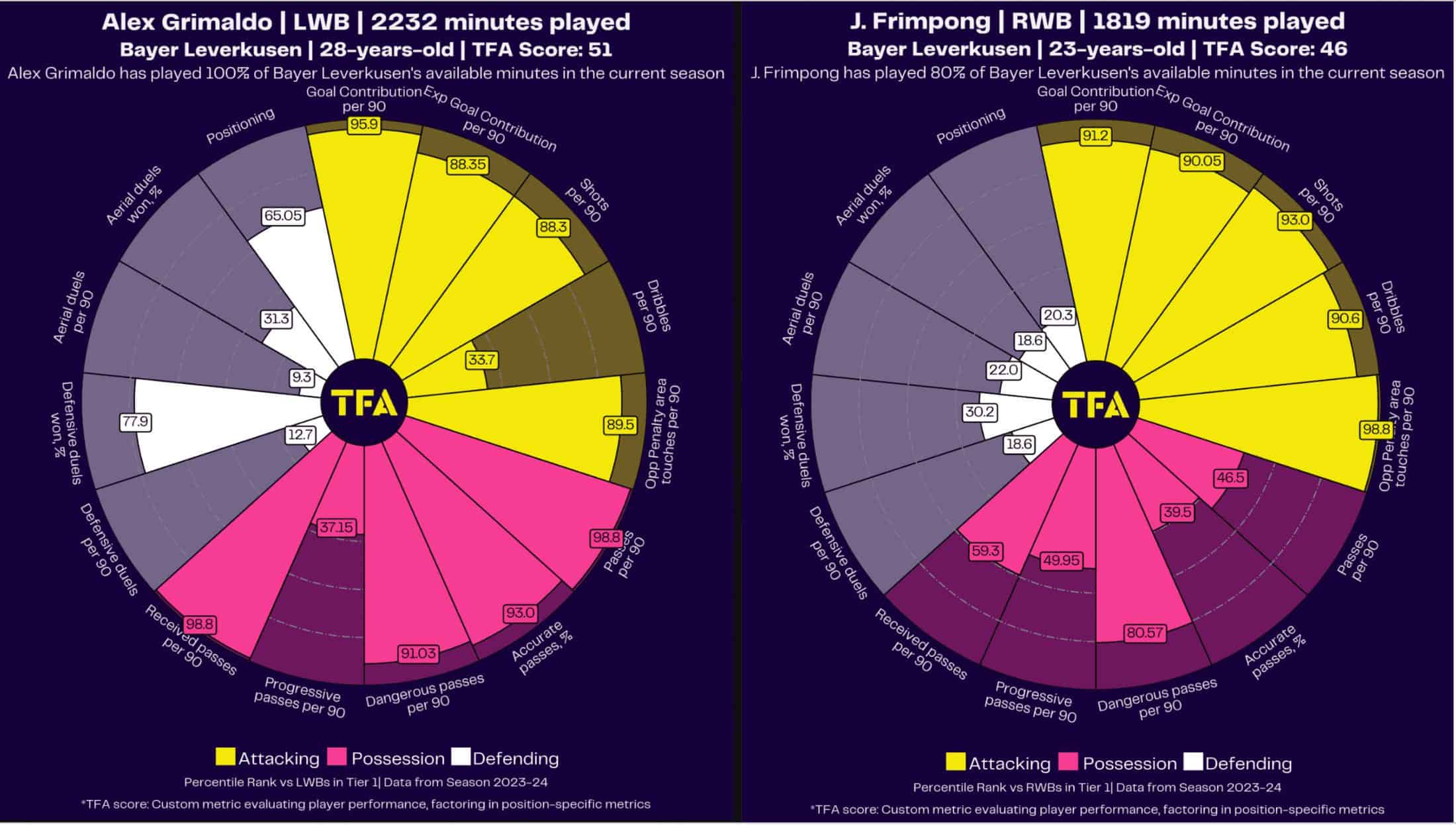
Regarding their in-possession roles, Grimaldo and Frimpong have both been utilised in a highly aggressive, attacking manner, featuring very little in the first two phases of possession play, coming to life almost exclusively in the final third.
Their primary contributions to Leverkusen come in regard to chance creation — this is demonstrated by the fact they both have fairly low percentile ranks in progressive passes per 90 on the 2023/24 pizza charts above in figure 1 but boast highly impressive numbers in the dangerous passes department, along with goal contributions, expected goal contributions and shots.
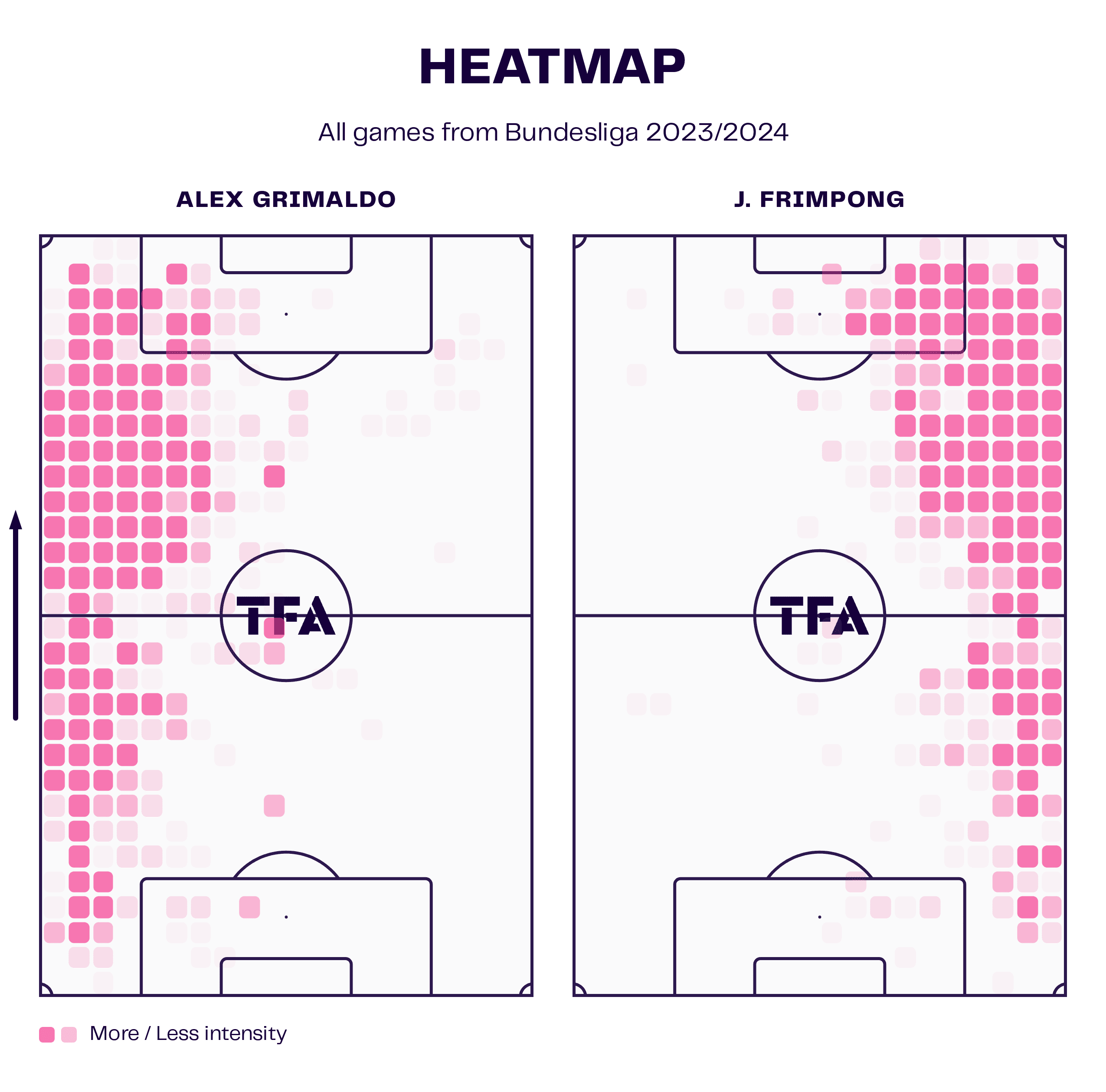
The duo’s respective heatmaps for the 2023/24 campaign further illustrate their advanced roles within Alonso’s system. Grimaldo is slightly more involved in deeper areas than Frimpong, who almost exclusively operates inside the opposition’s half, but both players still clearly engage far more in advanced areas than deeper ones.
It’s worth noting, also, how these two don’t just hug the sidelines and provide width for their team in the final third; they also get involved in slightly more central areas — Grimaldo in the half-space just outside the penalty area and Frimpong inside the box.
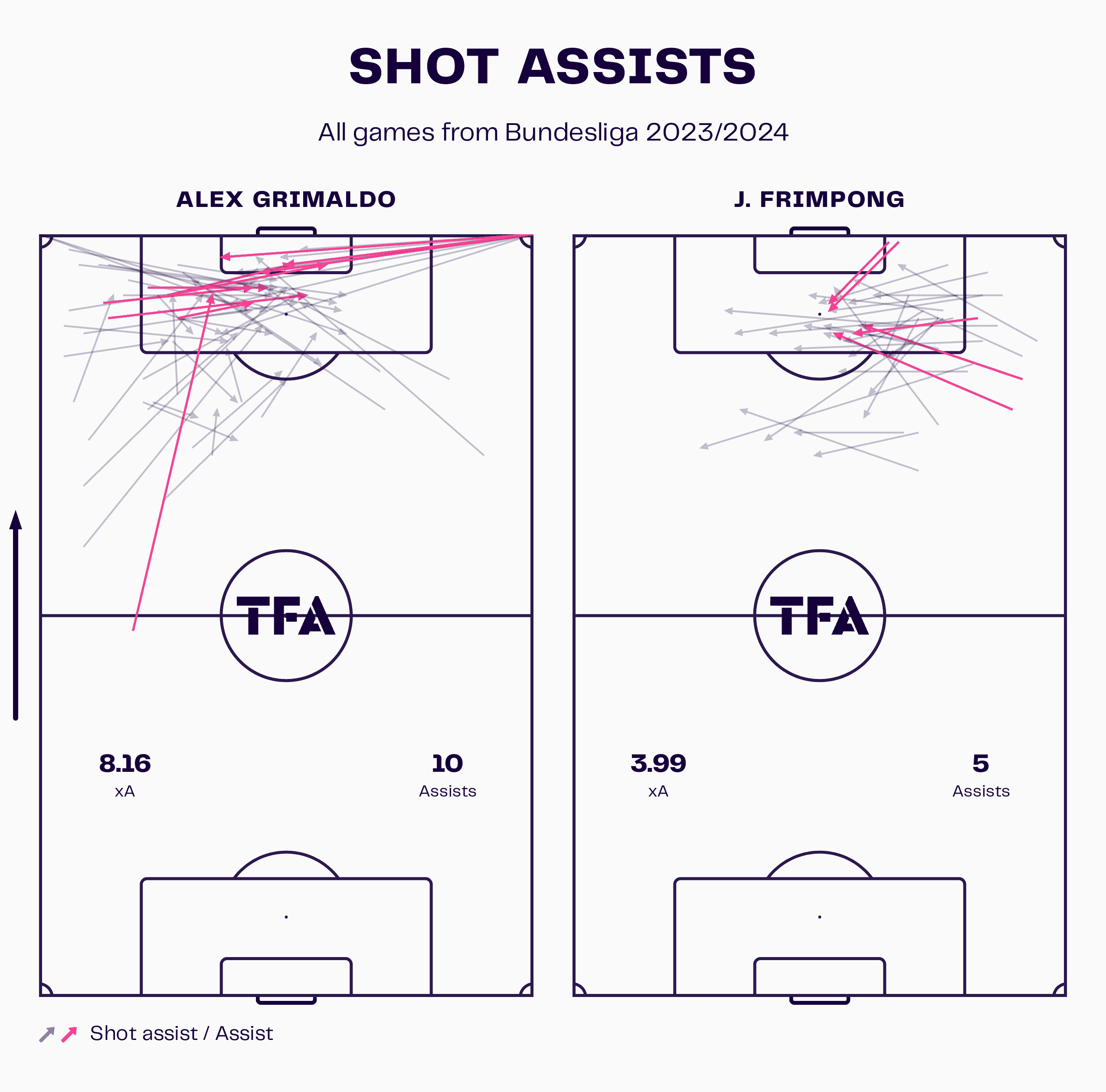
This inversion in the final third is partly displayed by the two players’ shot assist maps in figure 3, where we can see plenty of Grimaldo’s shot assists coming from that half-space area just outside the box and a decent amount of Frimpong’s shot assists being delivered from the edge of the box or just inside the box — the Dutch right wing-back loves to perform a cutback cross into the danger zone as depicted by the image above.
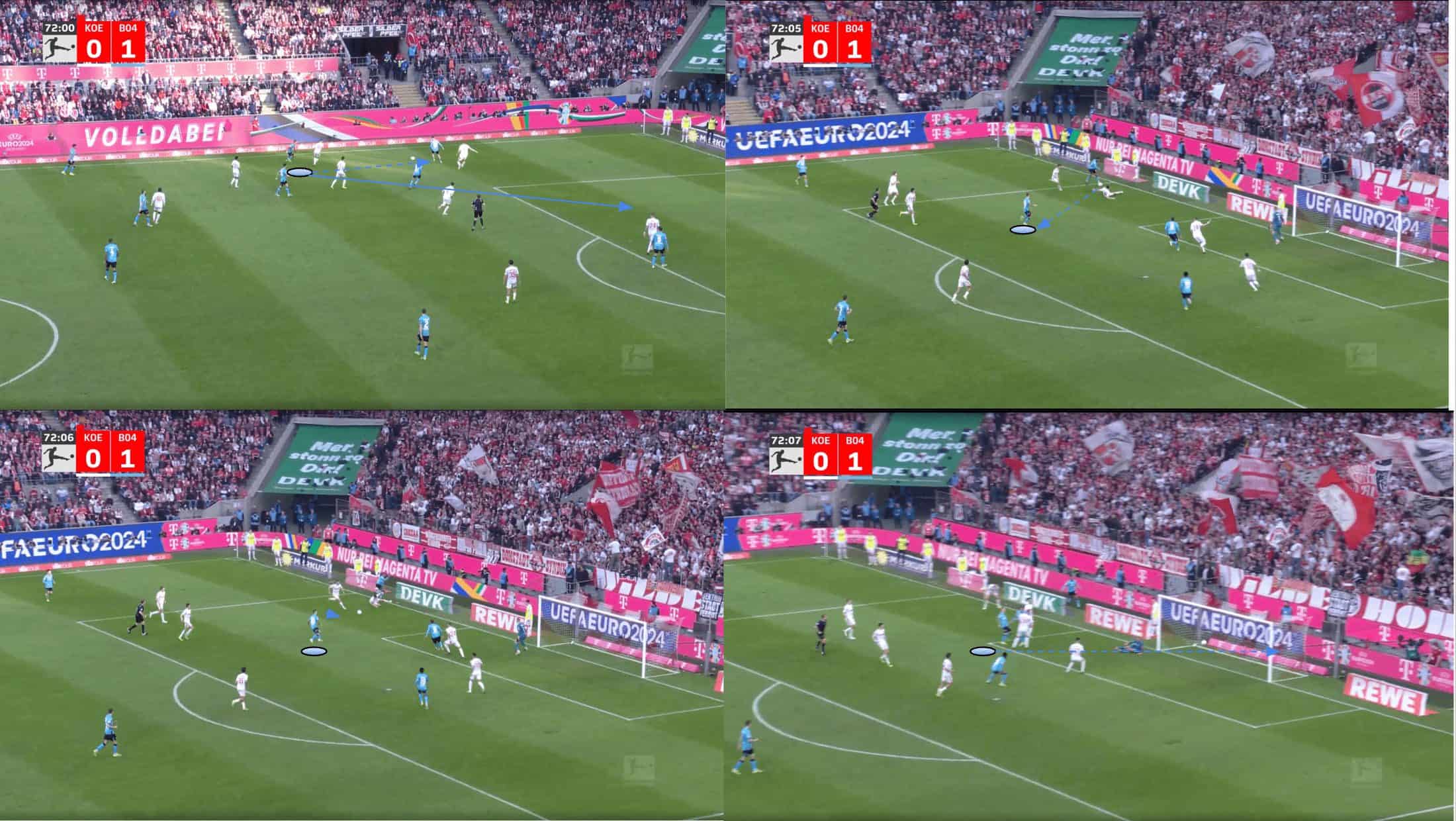
The out-to-in runs of Grimaldo and Frimpong also help them end up in good shooting positions quite often, which is why both men have contributed a significant amount of goals, as well as goal assists, this term.
Grimaldo has generated the fifth-highest xG (4.01) and scored the second-most goals (nine) of any Bayer Leverkusen player in the Bundesliga this season. Underlapping runs like the one we see following some link-up play outside the box in figure 4 above have played a vital role in his goal contributions, as the opposition defence simply doesn’t prepare for the left wing-back to be arriving in such an advanced position; as a result, Grimaldo often finds himself in space with time to shoot from a dangerous position as was the case for the goal above.
Aggressive overlapping runs from left centre-back Piero Hincapié are critical to the success of Grimaldo’s underlapping runs often. This ensures the opposition remains stretched often, creating more space for the inverting wing-back to exploit.
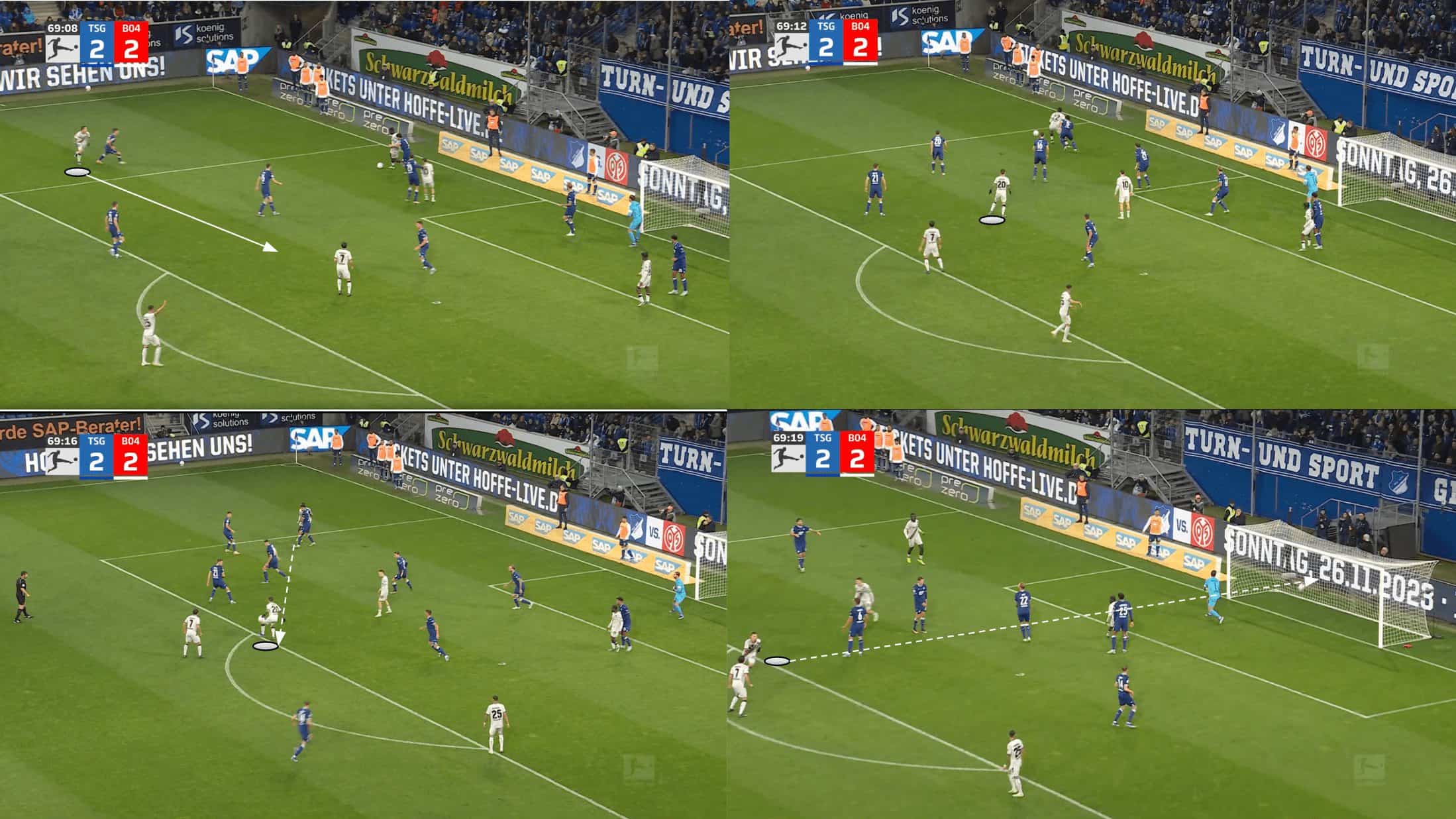
We find another example of this in figure 5 above, where the Spanish wing-back pulls away off the opposition full-back’s shoulder, losing his marker while he picks up a nice shooting position inside the box, between several defenders but not very near any of them.
This is unexpected movement for a wing-back; his marker out wide doesn’t follow him as it’s too narrow, but none of the central defenders pick him up either, with other threats already clocked in more traditional attacking positions.
The result, again, is that Grimaldo gets a free shot from a dangerous area — and the 28-year-old has shown throughout the 2023/24 campaign that he doesn’t to be asked too many times to convert his opportunities.
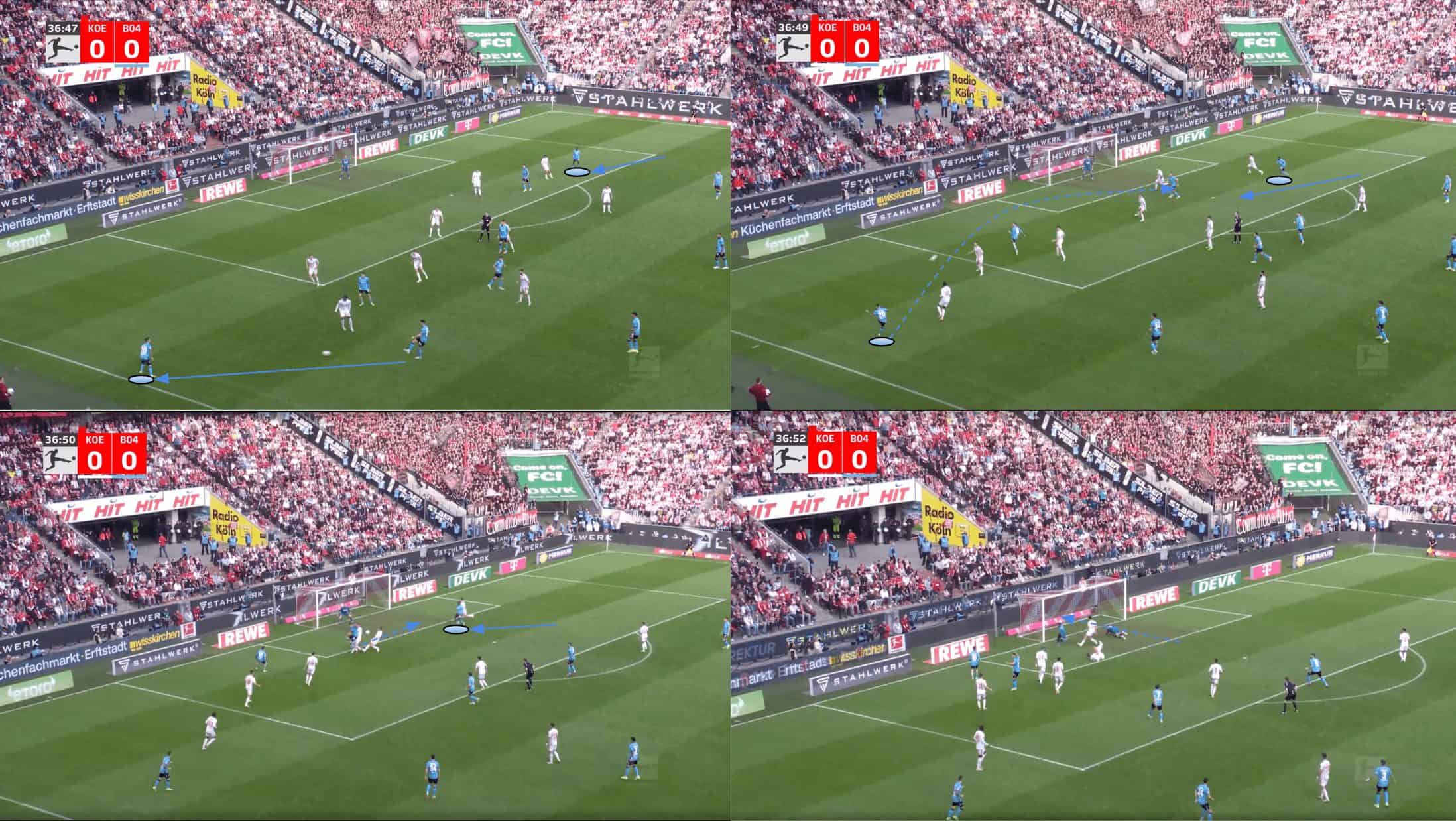
Alonso has also used Frimpong in a very aggressive manner but somewhat differently to the way in which he’s utilised Grimaldo.
Leverkusen love to build their chance creation on the left — doing so a great deal more than they do on the right. When this is the case, Frimpong doesn’t typically hold the width out on the right. Instead, he moves inside, attacking the box and offering a crossing option for his left-sided counterpart.
The 23-year-old Dutchman has generated the second-highest xG (7.37) and scored the third-most goals (eight) of any member of Alonso’s squad this term — and a lot of his chances have come as a result of him drifting into an excellent goalscoring position inside the box, evading a marker and finding some space to get a nice shot off and convert, as we see in figure 6 above.
Again, the opposition defence isn’t always prepared for this aggressive movement into central areas from the wing-back, which can allow the player to evade detection until it’s too late. Frimpong’s runs from out-to-in at the back post have been highly effective at helping his team generate a plethora of goalscoring opportunities this term.
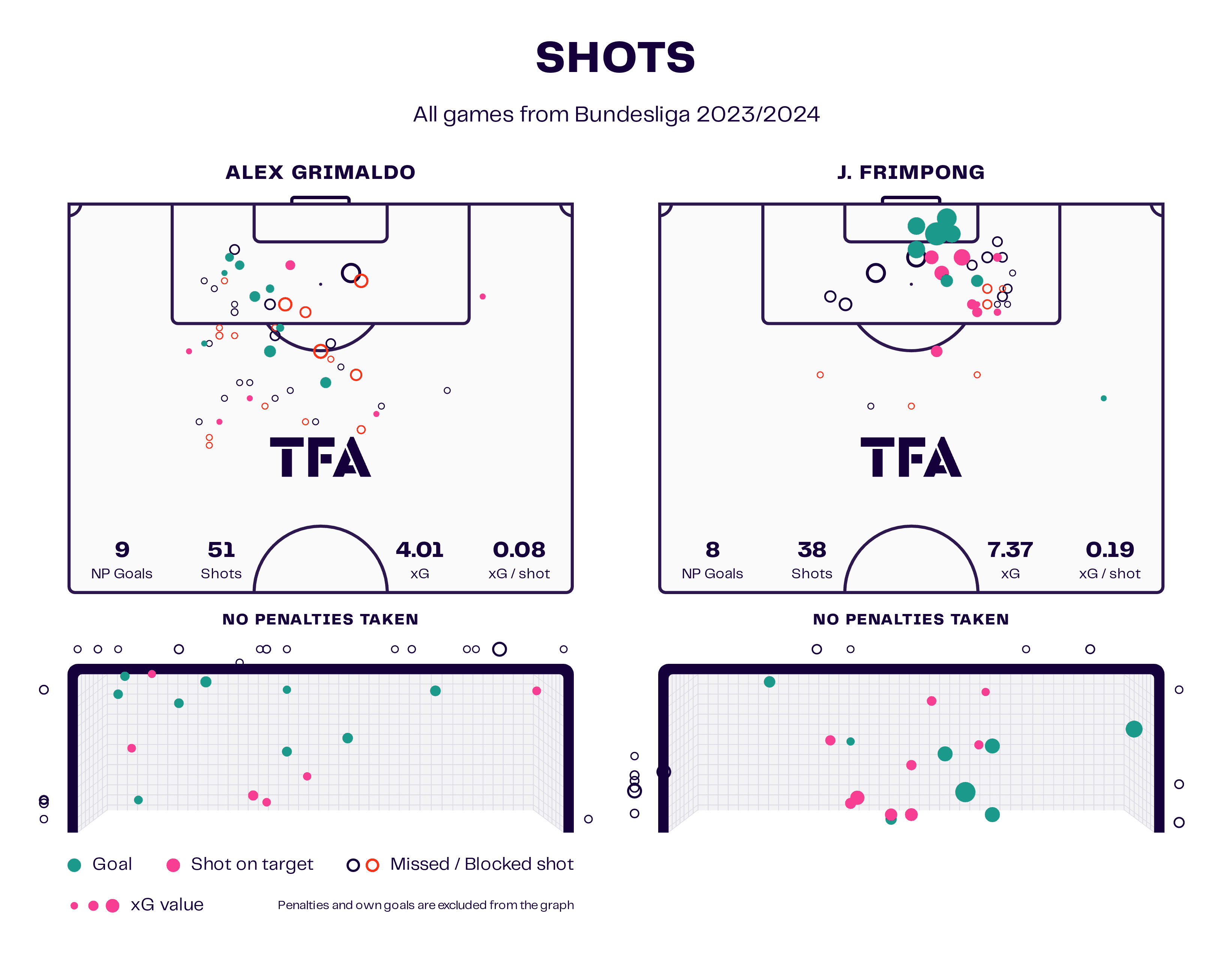
Figure 7 illustrates the two wingbacks’ differing goalscoring roles. Grimaldo (51) has taken more shots than Frimpong (38), but those shots have typically come from slightly worse positions (0.08 xG per shot). Still, he’s outperformed his xG and converted a nice amount (nine)—a result of some excellent finishing on his behalf this term.
Meanwhile, Frimpong has demonstrated positioning and movement that a striker would envy, generating 0.19 xG per shot this season. Together, they’ve proven a lethal force, contributing over a quarter of their team’s goals between them — and that’s before mentioning their combined total of 15 assists.
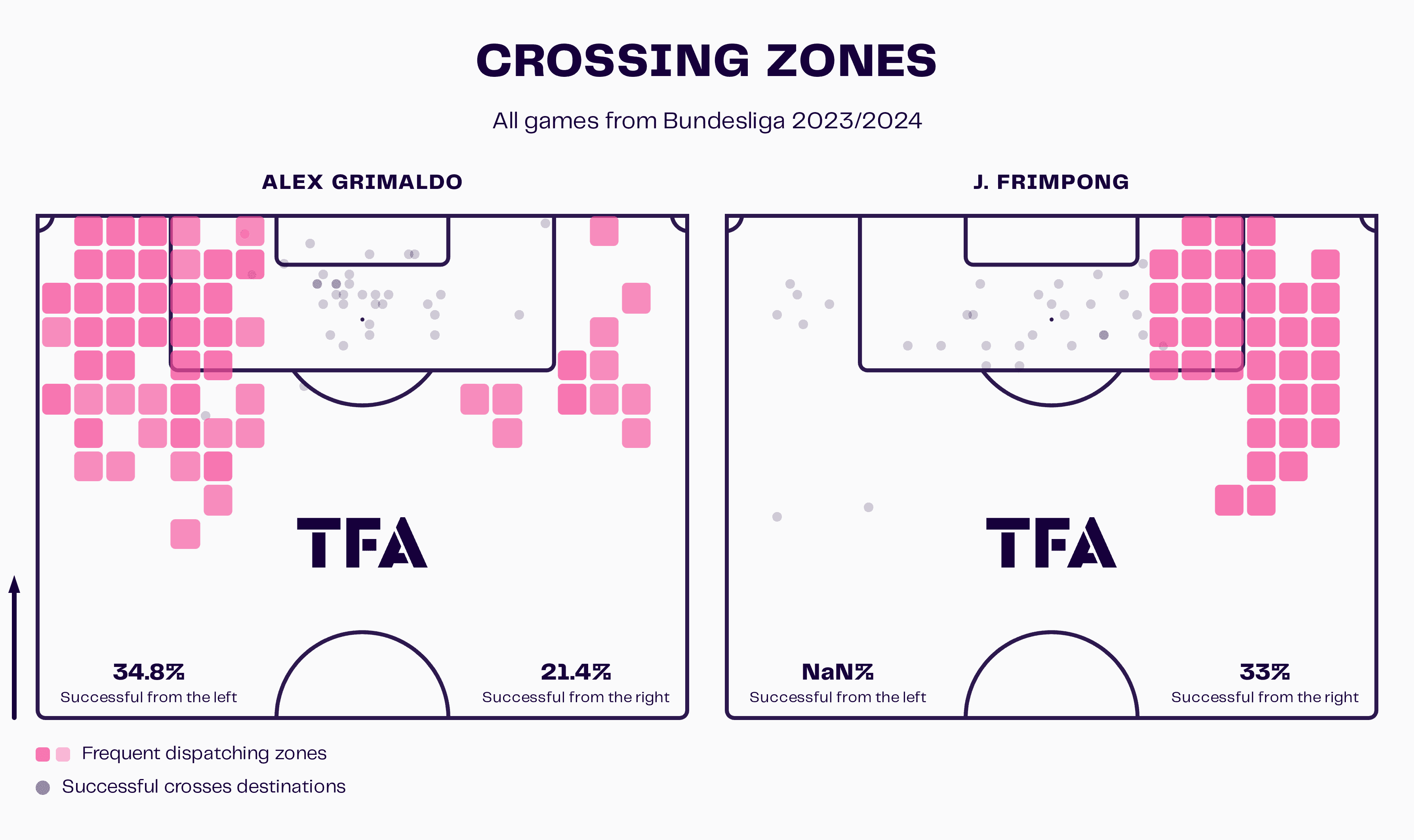
Grimaldo’s crossing has been pinpoint throughout the 2023/24 campaign, proving crucial to his accumulation of 8.16 expected assists and 10 actual assists — both the most of any Leverkusen player.
Frimpong’s crossing, meanwhile, has been a little less consistent, but the 23-year-old has still made five assists — the fifth-most of any Leverkusen player — and generated the fourth-most expected assists (3.99) in the team.
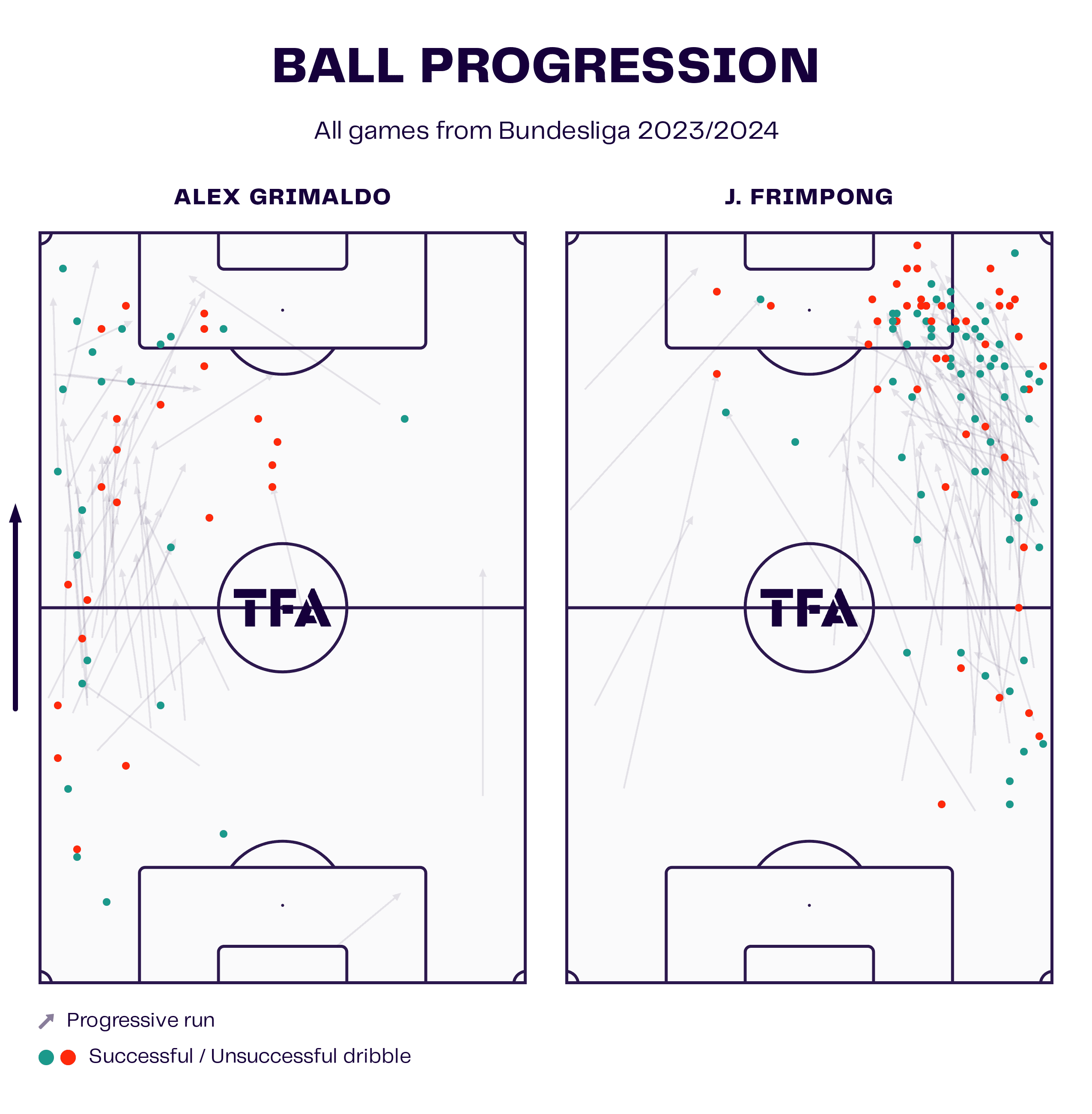
With regards to ball progression, the viz above in figure 9 highlights this duo’s dribbling activity from 2023/24.
Frimpong is a high-volume dribbler, which is a significant part of his game, especially in the final third, as figure 9 displays. The Dutchman ranks in the 90.9 percentile for dribbles per 90 in Europe’s top-five leagues among right wing-backs this season.
On the other hand, dribbling is not a major aspect of Grimaldo’s game, with the Spaniard falling in the 33.7 percentile for dribbles per 90 among left wing-backs from Europe’s top-five leagues in 2023/24.
When it comes to entering the final third, it’s far more common to see Grimaldo engaging in intricate link play and utilise intelligent off-the-ball movement to enter dangerous areas than Frimpong, while Leverkusen’s right wing-back is more likely to take opposition defenders on in 1v1s and rely a lot on his technical capability with the ball at his feet as well as his pace.
With regard to progressive passing, you’re not likely to see either of these two heavily involved in deeper areas from where these types of balls are more likely to be played as a result of their respective roles within Alonso’s team, as already described. However, Grimaldo does play some line-splitting balls towards the box from the edge of the final third at times, which can prove effective at getting the likes of attacking midfielder Florian Wirtz — another creative force in this team — involved in the game.
Still, it’s worth bearing in mind that Alonso uses these two primarily as chance creators and goalscoring threats inside the final third, with little involvement in possession phases outside of that.
Simone Inzaghi’s Inter
So, how does Alonso’s use of wing-backs at Bayer Leverkusen compare with that of his counterparts in a couple of Europe’s other strongest leagues who are also dominating their domestic competition this term?
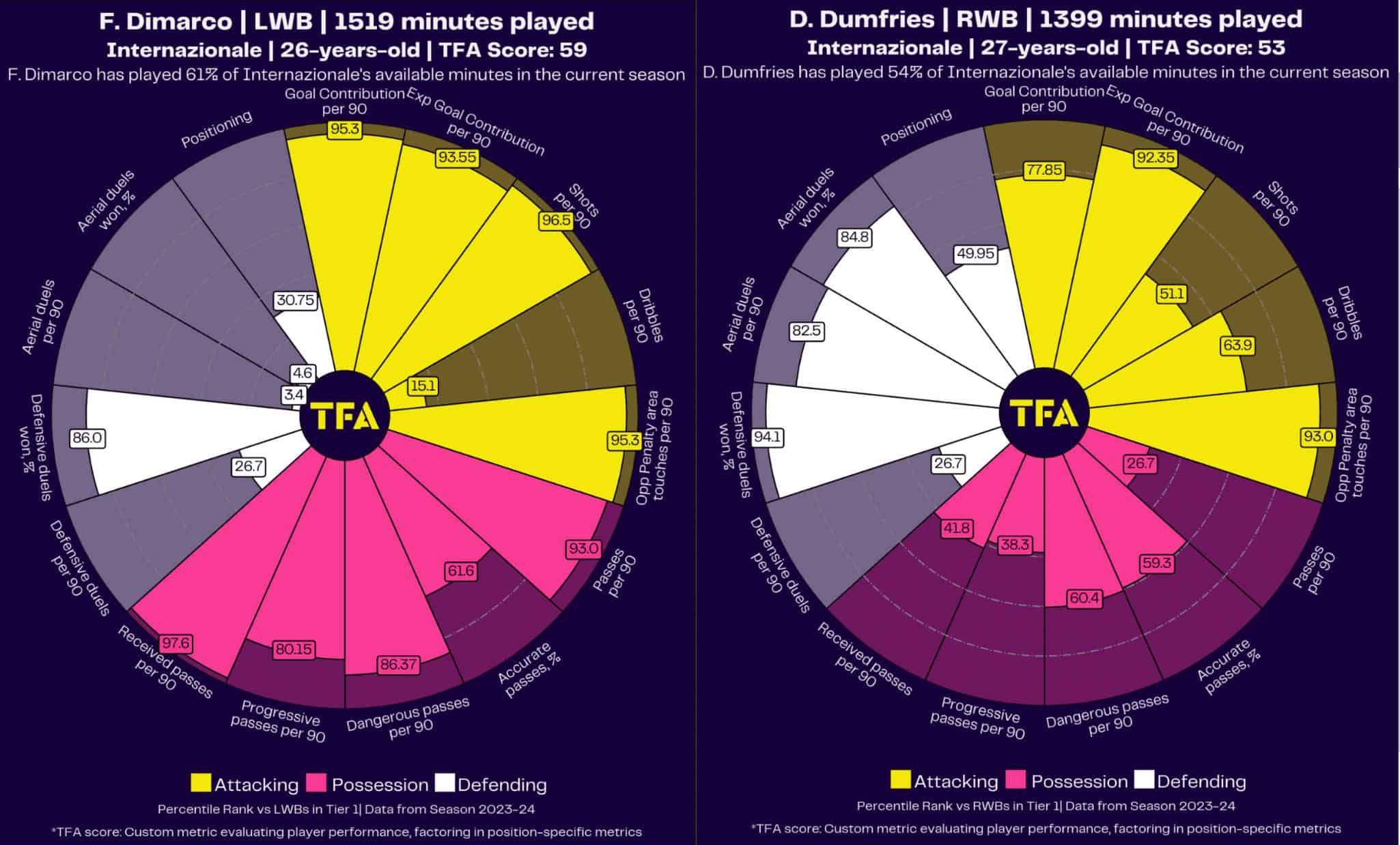
Firstly, let’s head over to Italy, where Simone Inzaghi has primarily utilised a 3-5-2 system with Inter this term. At the time of writing, I Nerazzurri lead city rivals AC Milan by 14 points with nine games left to be played in Italy’s top-flight this term.
The role of Federico Dimarco at left wing-back has been of particular interest in this Inter setup, with the 26-year-old playing a pivotal role in chance creation, similar to Leverkusen’s Grimaldo.
Dimarco has generated the most expected assists (5.94) and made the highest number of assists (six) of any Inter player during the current campaign. At the same time, he’s also taken a decent number of shots for a left wing-back but doesn’t come close to Grimaldo’s numbers in that particular department.
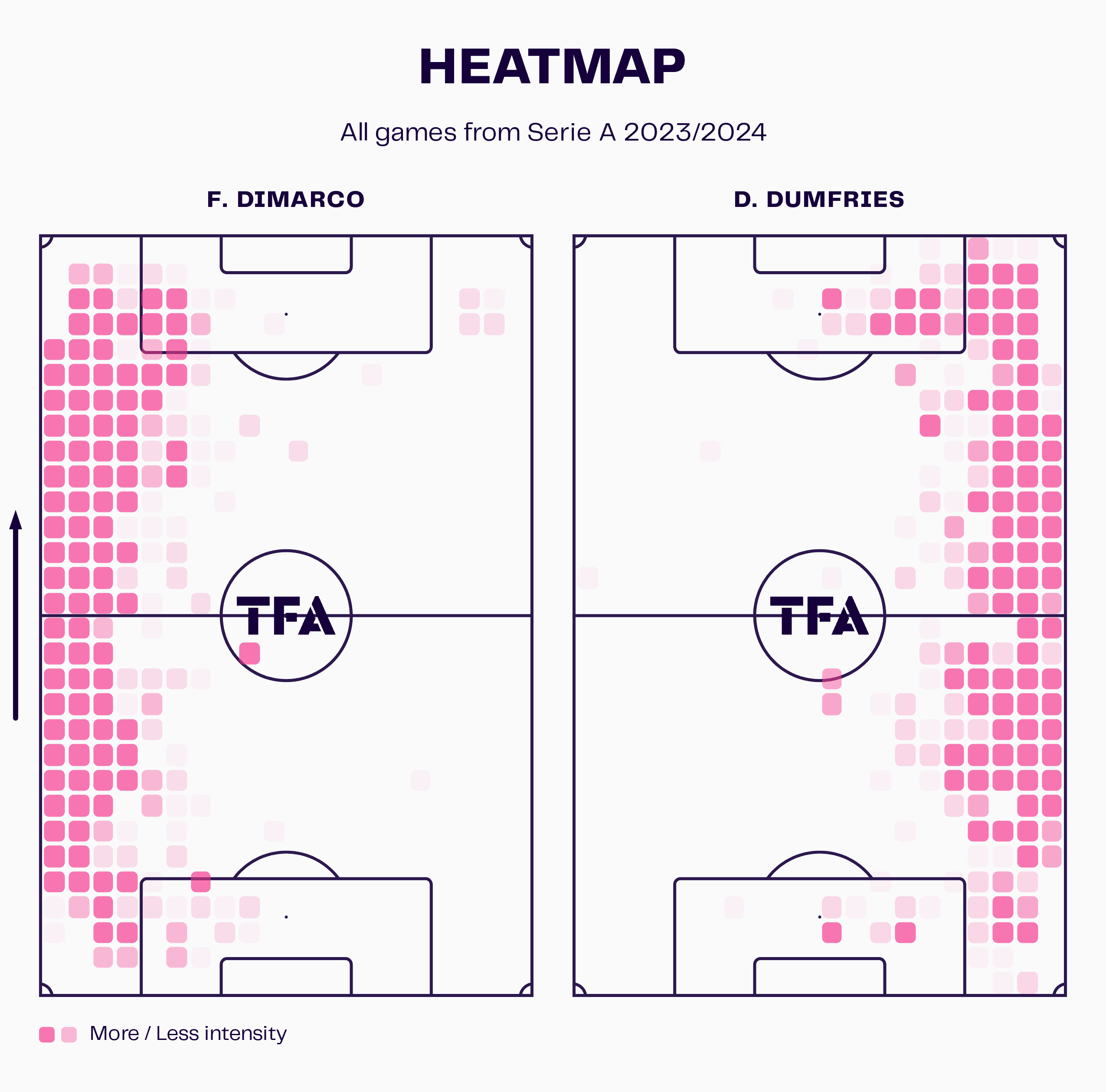
Inzaghi tends to deploy his wing-backs in a slightly more traditional manner than Alonso when it comes to their positioning, with Dimarco and Denzel Dumfries hugging the touchline a lot more than Grimaldo and Frimpong do with Leverkusen.
The Inter duo’s respective heatmaps show that they tend to stay much wider than Leverkusen’s wing-backs, making out-to-in runs a lot less frequently.
This sees them perform more exclusively as width providers in the final third, allowing the striking duo and attacking midfielder(s) to perform the central attacking roles.
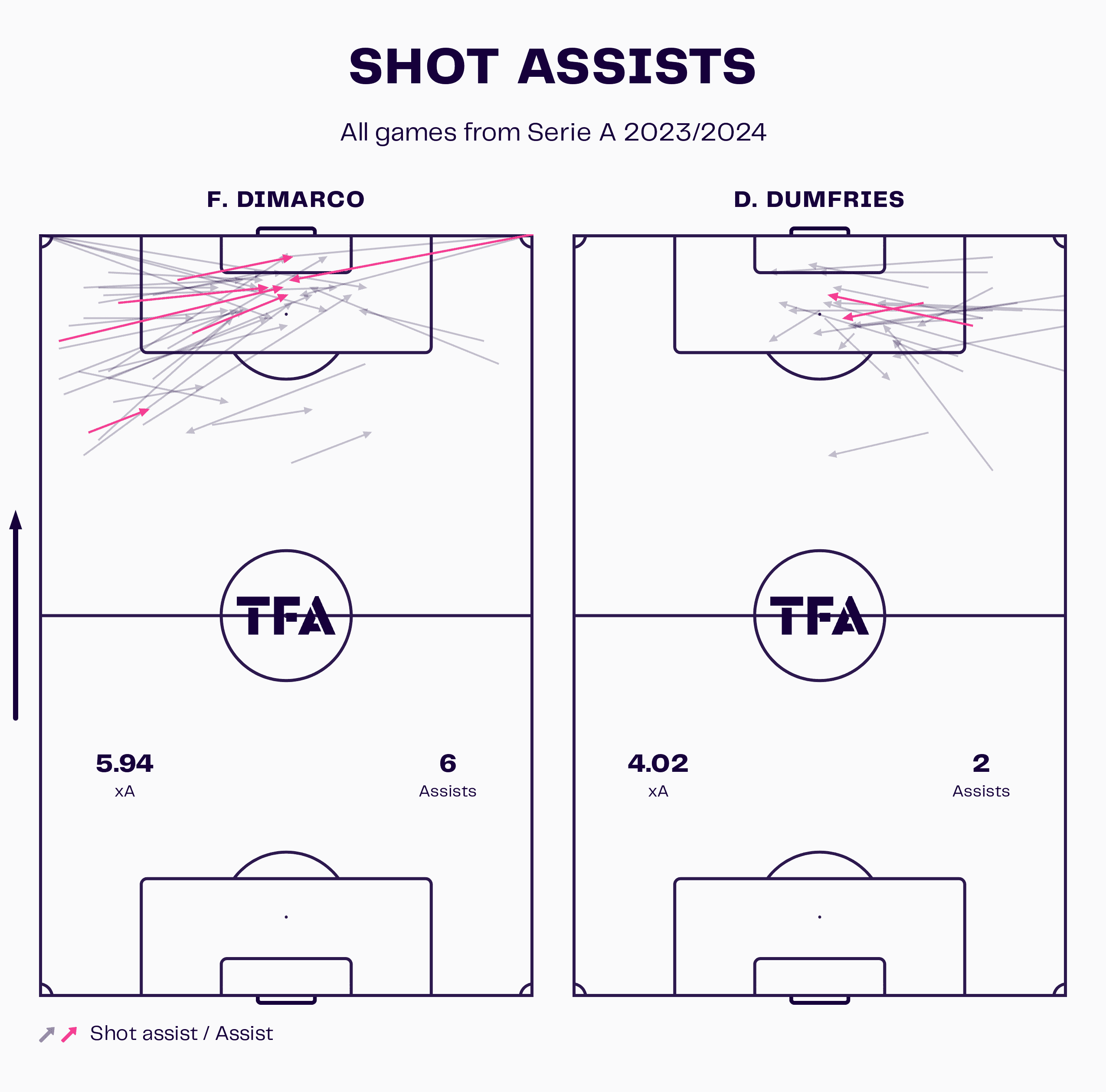
Similarly, Dimarco’s shot assist map in figure 12 differs from that of Grimaldo in that, as you might surmise from the analysis above, there’s far less chance creation coming from the half-space; instead, the 26-year-old’s shot assists all pretty much come from the wing — as is the case with Dumfries on the right.
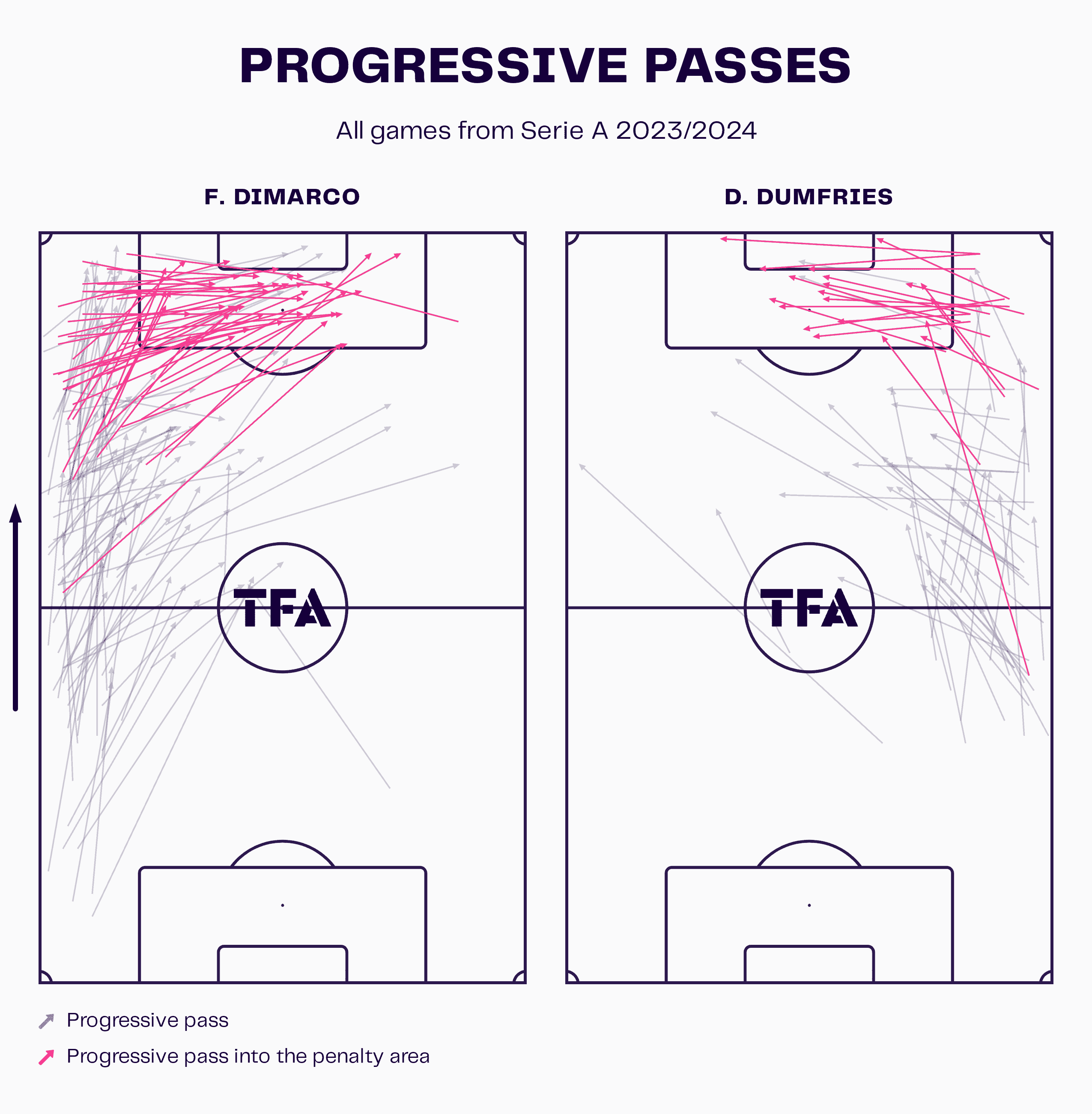
In the build-up, Inzaghi’s two wide centre-backs tend to sit on the sidelines while the central centre-back and one central midfielder will split wide of the goalkeeper, forming something of a back-four. Dimarco and Dumfries then advance, picking up positions on either side of the remaining two midfielders behind the striking duo, so they essentially create a 4-4-2 structure with Dimarco and Dumfries playing as the wingers.
Dumfries tends to remain higher, becoming an option for his deeper players as they play out from the back on occasion, but rarely offering much in terms of ball progression from deep outside of sometimes receiving if needed.
Dimarco, on the other hand, offers much more as a progressor, falling in the 80.15 percentile for progressive passes per 90 this term compared to 38.3 for Dumfries when ranked among players in their position from Europe’s top-five leagues.
Of the four wing-backs we’ve analysed so far in this piece, Dimarco is the one most likely to receive with a good body shape inside his own half and pick out a runner in a more advanced position, moving his team upfield in this manner.
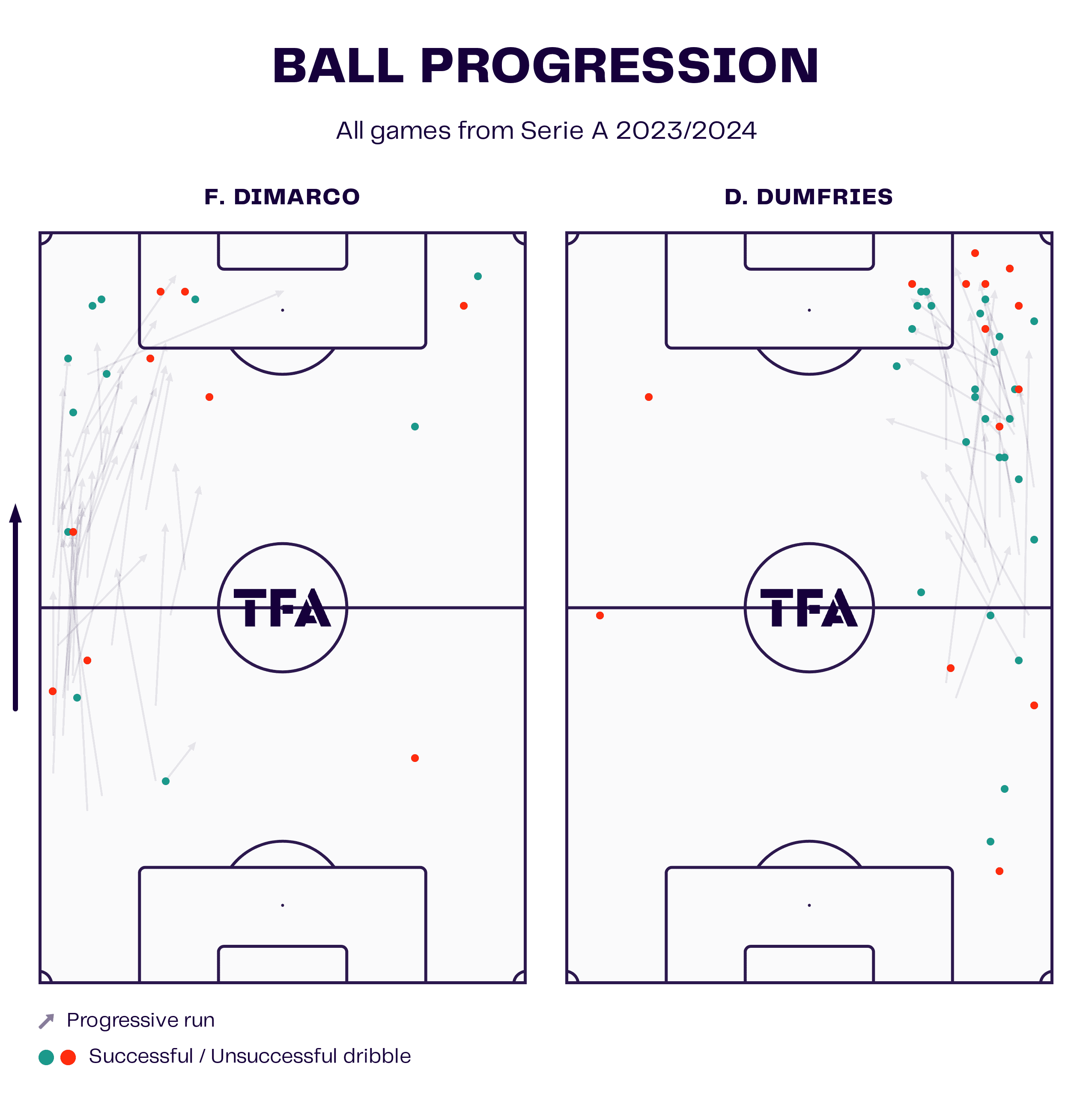
However, like Grimaldo but perhaps an even more extreme version, Dimarco doesn’t dribble much at all, preferring to do his progression via passing, off-the-ball movement and intricate link play.
Dumfries, on the other hand, likes to take opposition defenders on in the final third a decent amount but doesn’t come near the dribble volume of his compatriot Frimpong, all the same. Still, I’d class dribbling as a strength in the 27-year-old Dutchman’s game — he’s capable of beating his man and carrying into a decent position for chance creation.
All in all, in Inzaghi’s side, the wing-backs again prove crucial when it comes to chance creation, but this time, there’s a clear standout in Dimarco on the left compared with Dumfries on the right.
Rúben Amorim’s Sporting CP
Lastly, let’s head to Lisbon, where Rúben Amorim is on course to guide Sporting CP to their 20th Portuguese top-flight title and what would be only their fourth since the turn of the millennium this season. Sporting currently sit just one point ahead of Benfica at the time of writing this piece, though they do also have a game in hand.
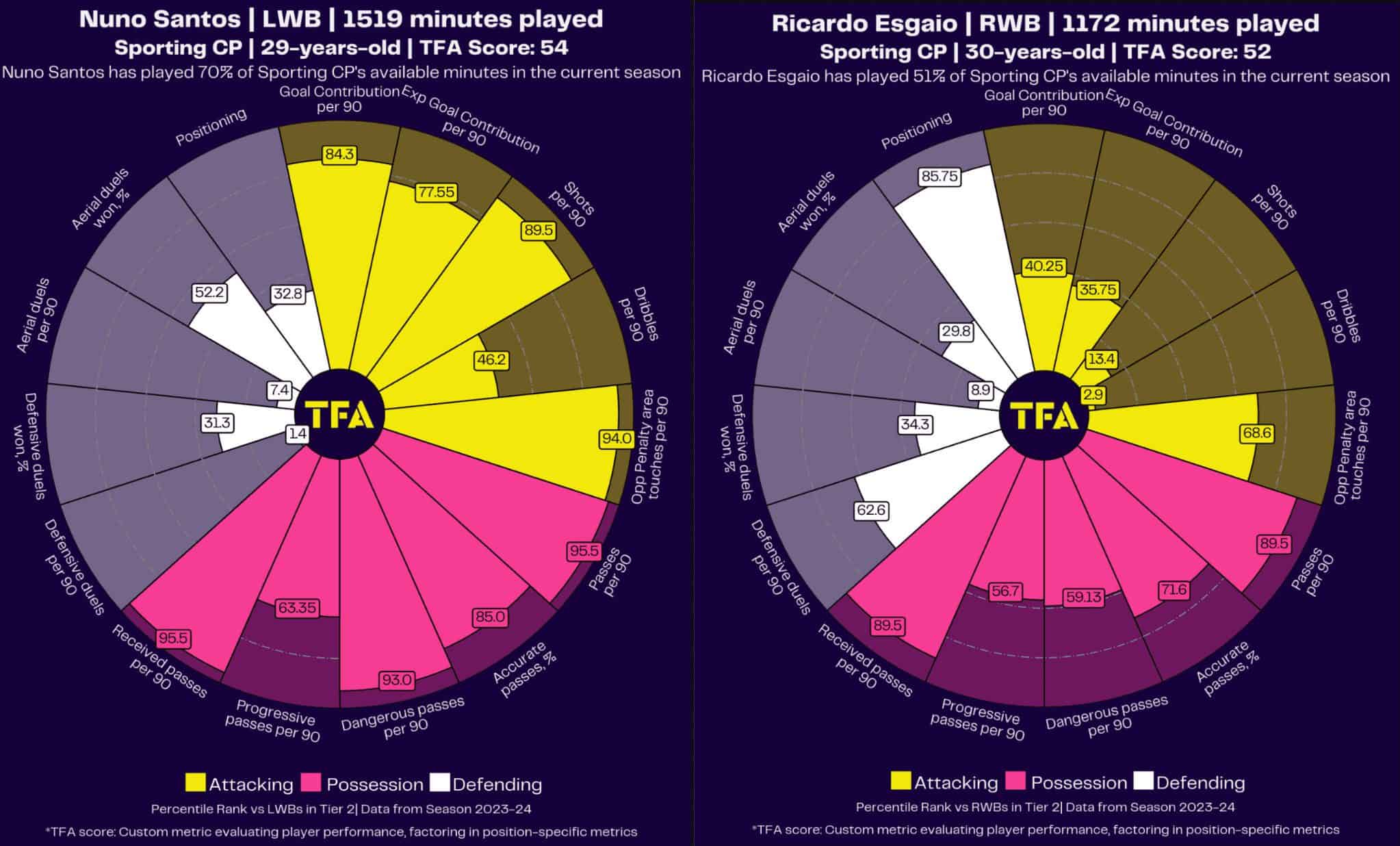
Nuno Santos (left) and Ricardo Esgaio (right) have been Amorim’s primary wing-back duo at Estádio José Alvalade this term, with Amorim mostly utilising a 3-4-3 shape similar to Xabi Alonso. However, Amorim’s use of wing-backs is significantly different to that of the Bayer Leverkusen boss, with the 39-year-old Sporting boss having less creative flair on the wings than either Alonso or Inzaghi.
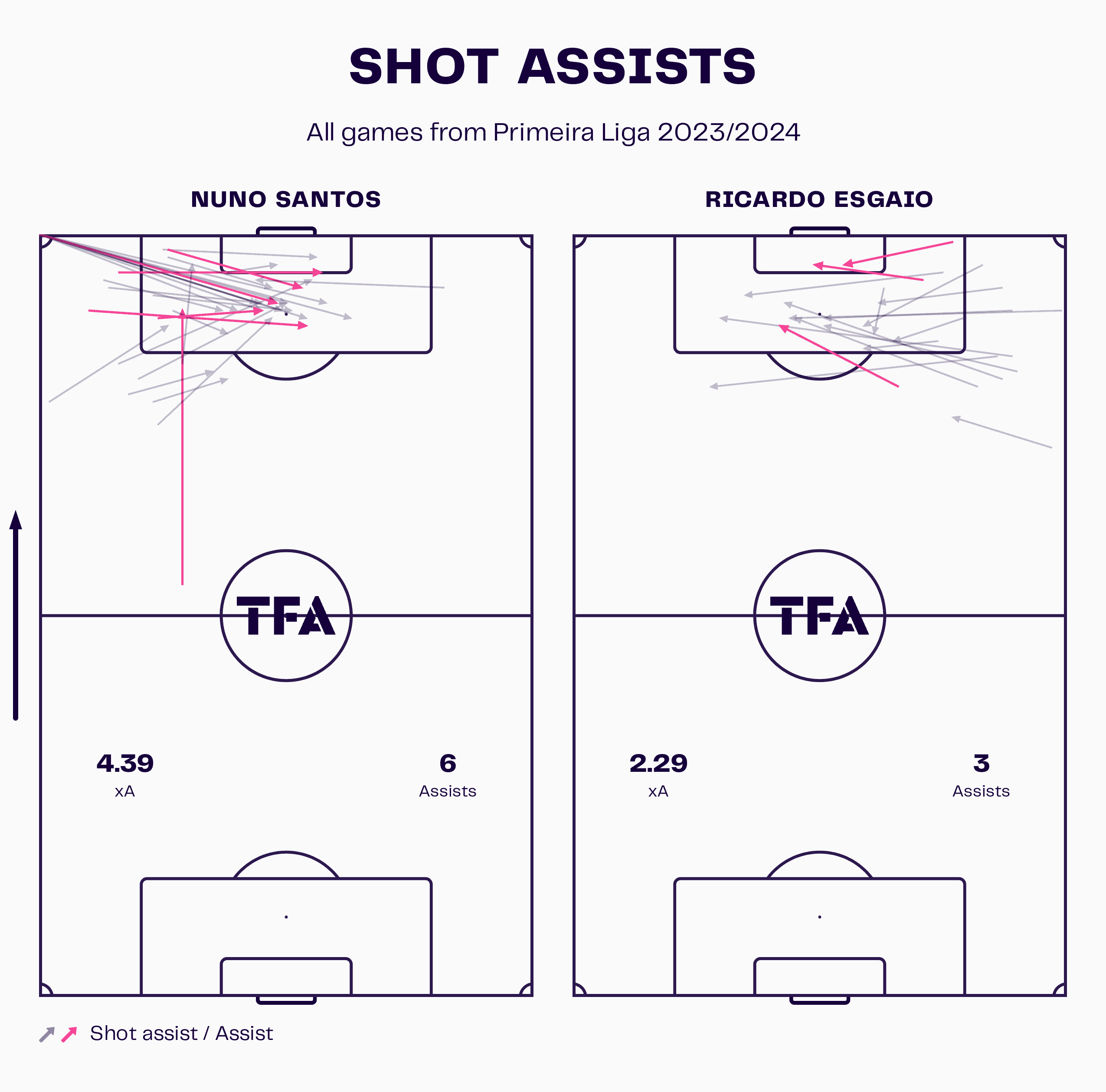
At Leverkusen (Grimaldo) and Inter (Dimarco), the primary creator for the 2023/24 season has been a wing-back — the left wing-back on both occasions. However, that’s not the case at Sporting, where 25-year-old winger and attacking midfielder Pedro Gonçalves has both generated the most expected assists (7.02) and provided the most assists (nine) for Leões in the league this season.
Nevertheless, Sporting’s main left wing-back, Nuno Santos, has also contributed a decent amount to his team’s chance creation this term, generating the fourth-most expected assists (4.39) and providing the second-most assists (six) in the team.
Like Dimarco, his shot assists mainly tend to come from wider positions as opposed to the half-space like Grimaldo, but Santos makes a lot more shorter crosses. In contrast, Dimarco would typically cross the ball from wider positions.
Esgaio, meanwhile, has generated the seventh-highest xA (2.29) and joint-fifth-highest assists tally (three) of any Sporting player in the 2023/24 campaign, which is still notable but does ultimately leave him with quite unimpressive numbers for goal contributions and expected goal contributions on the pizza chart above in figure 15, indicative of how this compares with his positional peers in the world’s ‘Tier 2’ leagues (the Portuguese Primeira Liga, Russian Premier League, EFL Championship, Turkish Süper Lig, Argentinian top-flight, Brazilian top-flight, Belgian Pro League and Dutch Eredivisie).
Esgaio’s chance creation primarily comes from underlapping runs through the half-space, between defenders and into the penalty box, where he’ll aim to receive a through ball before playing a cutback pass towards a high-percentage shooting position.
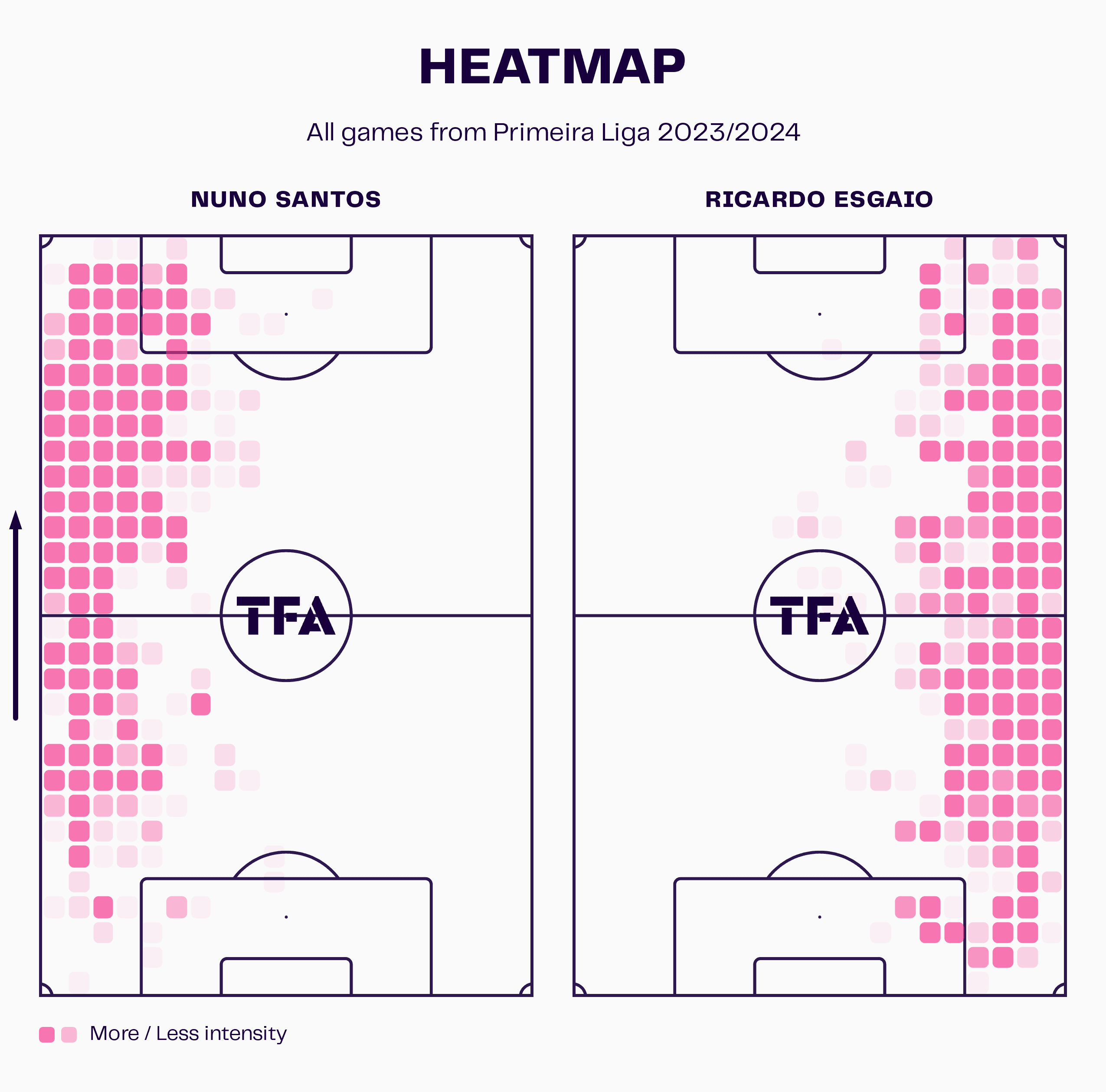
Esgaio is probably the most active wing-back in deep areas of the six included in this analysis, with Santos also getting involved in deeper areas a fair amount, dropping off and making himself available as a passing option as his team builds out from the back.
This also makes Santos and Esgaio the only wing-back duo to both have a high percentile rank in passes per 90, as indicated in figure 15 above of the three pairings analysed in this piece.
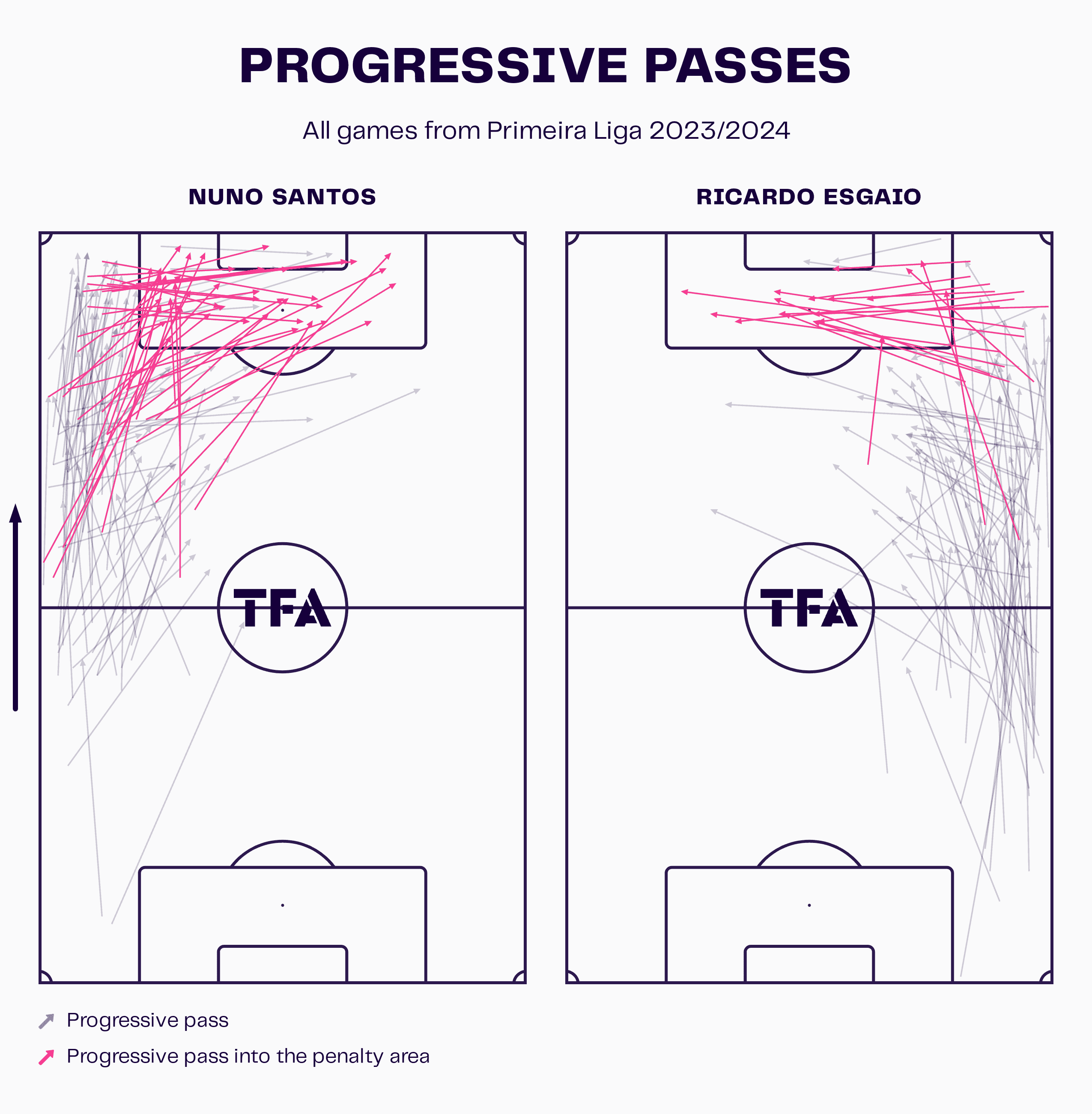
Both Esgaio and Santos also play a decent number of progressive passes too, also unique among the wing-back pairings analysed in this piece. As mentioned, Amorim’s wing-backs are not of the creative standard that Alonso and Inzaghi have at their disposal. However, the Sporting boss does boast plenty of creative quality in other parts of his team — particularly in midfield.
So, Amorim designs his team differently to Inzaghi and Alonso, utilising the wing-backs more as vessels for ball progression and less as creative outlets, though both still get forward, provide the width for their side and generate plenty of chances as teams focus on cutting off Sporting’s access to the box via the central positions, knowing the threat that exists there.
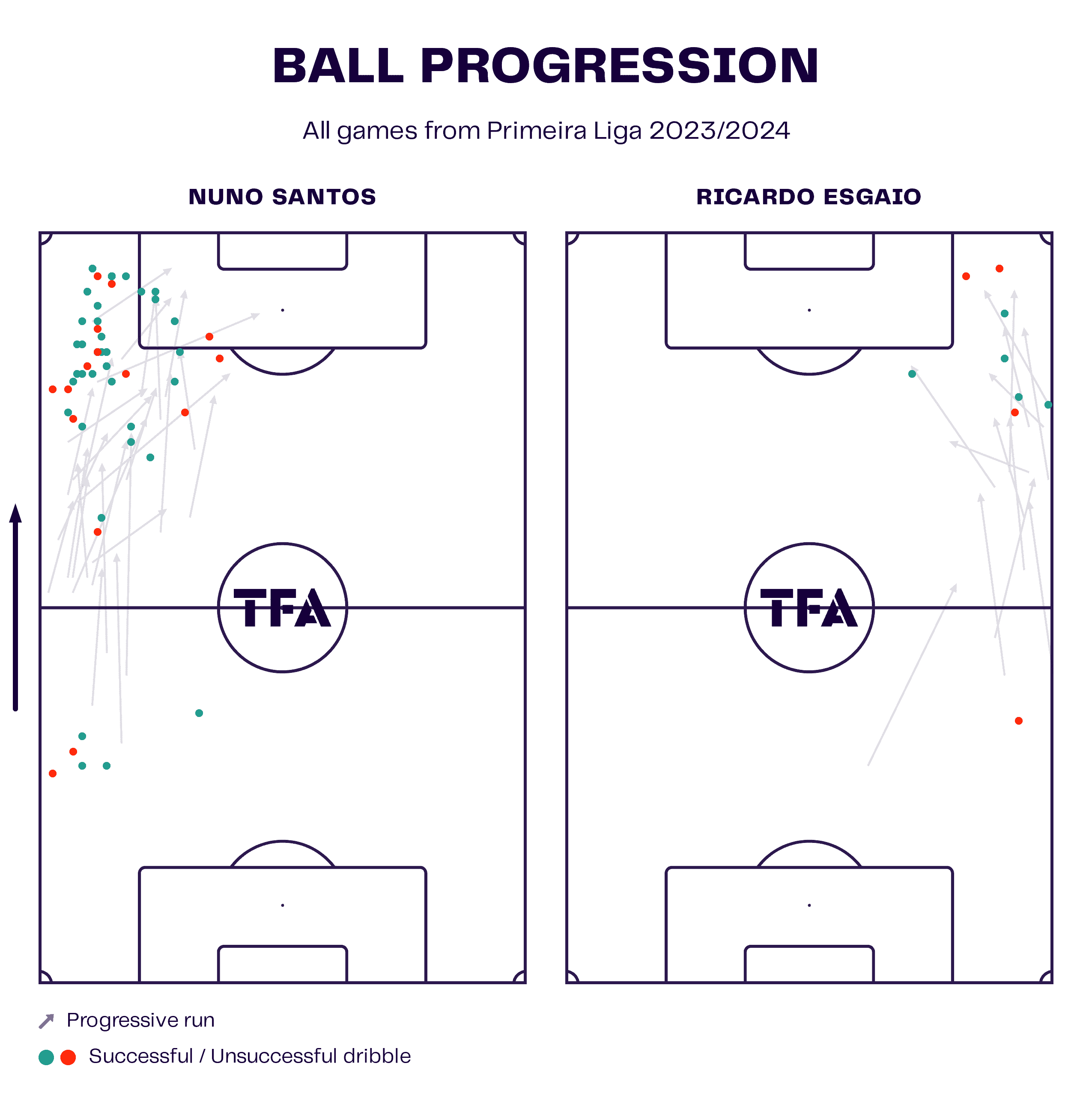
Don’t expect to see Esgaio or Santos making a tonne of dribbles; again, these types of actions are more common in other parts of this Sporting side, though Santos will perform more than Esgaio, the latter of whom primarily progresses into creative positions via his link play and off-the-ball runs.
Neither of these players are volume dribblers by any stretch of the imagination, with Santos being more likely to receive a long pass after making a run forward into space and crossing into the danger zone than he is to try and take players on 1v1 and drive into valuable positions with the use of his dribbling technique.
Conclusion
In conclusion, it’s safe to say Xabi Alonso has exhibited some of the most innovative, creative and, ultimately, effective usage of wing-backs in Europe this season with his inverted, aggressive wing-back pairing at Bayer Leverkusen. This usage does come with risks, especially in transition to defence, but Leverkusen have got to reap the rewards a lot more than they’ve had to suffer the consequences of such daring play this season.
Inzaghi at Inter and Amorim at Sporting have also succeeded with systems that have deployed wing-backs in key tactical roles this term, both in different ways to each other and Alonso. Inzaghi has used his wing-backs in crucial creative roles like Alonso but wider and in a more traditional manner, while Amorim has relied on his wing-backs for creativity too but more as ball progressors, with the creative burden more heavily shouldered by central players at Sporting.

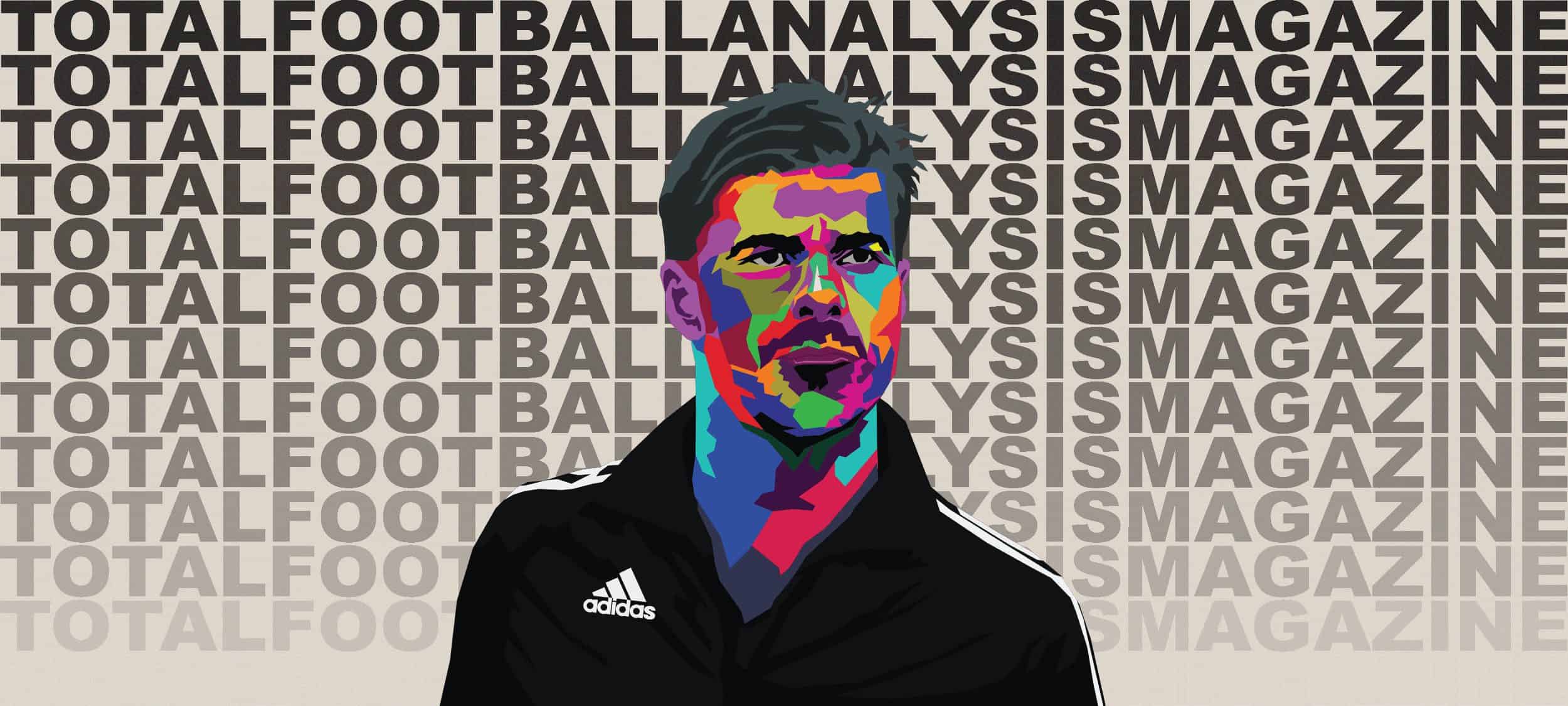



Comments